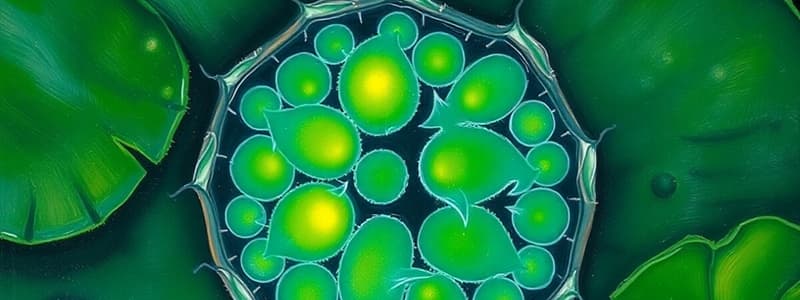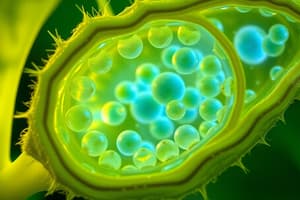Podcast
Questions and Answers
What is the primary role of lysosomes during endocytosis?
What is the primary role of lysosomes during endocytosis?
- To provide energy for the process
- To transport particles outside the cell
- To facilitate vesicle formation
- To break down the contents of the vesicle (correct)
Which sequence correctly describes the steps in exocytosis?
Which sequence correctly describes the steps in exocytosis?
- Vesicle surrounds particle, transports to nucleus, releases contents
- Vesicle forms, fuses with lysosome, releases contents
- Vesicle forms, fuses with cell membrane, releases contents (correct)
- Vesicle breaks down particle, fuses with endoplasmic reticulum, releases contents
Endocytosis is primarily used by cells to:
Endocytosis is primarily used by cells to:
- Synthesize proteins
- Remove waste from the cell
- Ingest large particles or substances (correct)
- Transport oxygen molecules
In which step of endocytosis does the cell membrane play a critical role?
In which step of endocytosis does the cell membrane play a critical role?
Which of the following statements is true about both endocytosis and exocytosis?
Which of the following statements is true about both endocytosis and exocytosis?
What defines active transport in cellular processes?
What defines active transport in cellular processes?
In which type of solution does a cell remain unchanged in size?
In which type of solution does a cell remain unchanged in size?
Which process involves the cell membrane engulfing external material?
Which process involves the cell membrane engulfing external material?
What differentiates osmosis from diffusion?
What differentiates osmosis from diffusion?
Which of the following statements about transport mechanisms is correct?
Which of the following statements about transport mechanisms is correct?
What role do lysosomes play in the cell?
What role do lysosomes play in the cell?
Which statement about centrosomes is correct?
Which statement about centrosomes is correct?
What is the primary function of vacuoles in plant cells?
What is the primary function of vacuoles in plant cells?
During cell division, which structure pulls apart the chromosomes?
During cell division, which structure pulls apart the chromosomes?
What distinguishes plant vacuoles from animal vacuoles?
What distinguishes plant vacuoles from animal vacuoles?
What role does a ligand play in cell signaling?
What role does a ligand play in cell signaling?
Which statement accurately describes membrane receptors?
Which statement accurately describes membrane receptors?
What is a key characteristic of intracellular receptors?
What is a key characteristic of intracellular receptors?
During passive transport, which process specifically involves the movement of water?
During passive transport, which process specifically involves the movement of water?
What distinguishes passive transport from active transport in cellular processes?
What distinguishes passive transport from active transport in cellular processes?
Which statement accurately reflects a principle of cell theory?
Which statement accurately reflects a principle of cell theory?
What is a defining characteristic of prokaryotic cells?
What is a defining characteristic of prokaryotic cells?
Which component is NOT found in the cytoplasm of both prokaryotic and eukaryotic cells?
Which component is NOT found in the cytoplasm of both prokaryotic and eukaryotic cells?
Which of the following correctly describes the cell membrane?
Which of the following correctly describes the cell membrane?
Which scientist contributed to the development of cell theory by stating that all cells arise from pre-existing cells?
Which scientist contributed to the development of cell theory by stating that all cells arise from pre-existing cells?
What role does cholesterol play in the structure of the cell membrane?
What role does cholesterol play in the structure of the cell membrane?
Which statement best describes the fluid mosaic model of the cell membrane?
Which statement best describes the fluid mosaic model of the cell membrane?
Which factor does NOT affect the selective permeability of the cell membrane?
Which factor does NOT affect the selective permeability of the cell membrane?
What type of molecules require specialized transport to cross the cell membrane?
What type of molecules require specialized transport to cross the cell membrane?
In terms of energy requirements, how do small non-polar molecules pass through the cell membrane?
In terms of energy requirements, how do small non-polar molecules pass through the cell membrane?
What is the primary function of chlorophyll in chloroplasts?
What is the primary function of chlorophyll in chloroplasts?
Which of the following accurately describes the composition of the cell membrane?
Which of the following accurately describes the composition of the cell membrane?
What describes the primary advantage of the cellulose composition of the cell wall?
What describes the primary advantage of the cellulose composition of the cell wall?
How does the cytoskeleton contribute to cell function?
How does the cytoskeleton contribute to cell function?
Which statement about the functions of the cell membrane is correct?
Which statement about the functions of the cell membrane is correct?
What distinguishes the Rough Endoplasmic Reticulum (RER) from the Smooth Endoplasmic Reticulum (SER)?
What distinguishes the Rough Endoplasmic Reticulum (RER) from the Smooth Endoplasmic Reticulum (SER)?
What role do vesicles play in the function of the Golgi apparatus?
What role do vesicles play in the function of the Golgi apparatus?
Which statement about the Smooth Endoplasmic Reticulum (SER) is true?
Which statement about the Smooth Endoplasmic Reticulum (SER) is true?
How do proteins achieve their final form after synthesis?
How do proteins achieve their final form after synthesis?
What structural feature of the Golgi apparatus aids its function?
What structural feature of the Golgi apparatus aids its function?
Which statement accurately describes the function of the nucleus in eukaryotic cells?
Which statement accurately describes the function of the nucleus in eukaryotic cells?
What is one significant structural feature of the mitochondrion?
What is one significant structural feature of the mitochondrion?
Which plastid type is primarily responsible for converting solar energy into chemical energy?
Which plastid type is primarily responsible for converting solar energy into chemical energy?
Which of the following statements about plastids is correct?
Which of the following statements about plastids is correct?
What key role does chlorophyll play in chloroplasts?
What key role does chlorophyll play in chloroplasts?
Flashcards
Cell Wall
Cell Wall
A strong, rigid layer made of cellulose that provides structural support, protection, and shape to plant cells.
Cytoskeleton
Cytoskeleton
A network of proteins that provides structural support and helps with movement within a cell. It's always changing to meet the cell's needs.
Chloroplasts
Chloroplasts
Organelles found in plant cells that convert light energy into chemical energy (glucose) through photosynthesis.
Cell Membrane
Cell Membrane
Signup and view all the flashcards
Phospholipid
Phospholipid
Signup and view all the flashcards
Endocytosis
Endocytosis
Signup and view all the flashcards
Step 1 of Endocytosis
Step 1 of Endocytosis
Signup and view all the flashcards
Step 3 of Endocytosis
Step 3 of Endocytosis
Signup and view all the flashcards
Exocytosis
Exocytosis
Signup and view all the flashcards
Step 3 of Exocytosis
Step 3 of Exocytosis
Signup and view all the flashcards
Cholesterol in Cell Membrane
Cholesterol in Cell Membrane
Signup and view all the flashcards
Transport Proteins
Transport Proteins
Signup and view all the flashcards
Selective Permeability
Selective Permeability
Signup and view all the flashcards
Fluid Mosaic Model
Fluid Mosaic Model
Signup and view all the flashcards
Facilitated Diffusion
Facilitated Diffusion
Signup and view all the flashcards
Diffusion
Diffusion
Signup and view all the flashcards
Osmosis
Osmosis
Signup and view all the flashcards
Active Transport
Active Transport
Signup and view all the flashcards
What is a receptor?
What is a receptor?
Signup and view all the flashcards
What is a ligand?
What is a ligand?
Signup and view all the flashcards
What are membrane receptors?
What are membrane receptors?
Signup and view all the flashcards
What is diffusion?
What is diffusion?
Signup and view all the flashcards
What is osmosis?
What is osmosis?
Signup and view all the flashcards
What is the rough endoplasmic reticulum (RER)?
What is the rough endoplasmic reticulum (RER)?
Signup and view all the flashcards
What is the smooth endoplasmic reticulum (SER)?
What is the smooth endoplasmic reticulum (SER)?
Signup and view all the flashcards
What is the Golgi apparatus?
What is the Golgi apparatus?
Signup and view all the flashcards
What are vesicles?
What are vesicles?
Signup and view all the flashcards
How do proteins move through the endomembrane system?
How do proteins move through the endomembrane system?
Signup and view all the flashcards
What is a cell?
What is a cell?
Signup and view all the flashcards
Cell Theory
Cell Theory
Signup and view all the flashcards
Prokaryotic cell
Prokaryotic cell
Signup and view all the flashcards
Eukaryotic cell
Eukaryotic cell
Signup and view all the flashcards
What is the nucleus?
What is the nucleus?
Signup and view all the flashcards
What is the function of mitochondria?
What is the function of mitochondria?
Signup and view all the flashcards
What are plastids?
What are plastids?
Signup and view all the flashcards
What are chloroplasts?
What are chloroplasts?
Signup and view all the flashcards
What is chlorophyll?
What is chlorophyll?
Signup and view all the flashcards
What are Lysosomes?
What are Lysosomes?
Signup and view all the flashcards
What are Centrioles?
What are Centrioles?
Signup and view all the flashcards
What are Vacuoles?
What are Vacuoles?
Signup and view all the flashcards
What is the function of the centrosome?
What is the function of the centrosome?
Signup and view all the flashcards
Study Notes
Cell Wall (Plant cell only)
- Made of cellulose, because water and other molecules can fit through the wall
- Very strong, has a rigid layer that gives protection and support
- Plant cells, not animal cells
Cytoskeleton
- A network of proteins that is constantly changing
- Gives the cell its shape
Chloroplasts (Plant cell only)
- Convert solar energy into chemical energy through photosynthesis
- Contains chlorophyll, which is a green molecule that plays a big role in photosynthesis
- Found in stacks of disk-shaped sacs (thylakoids) within an inner membrane
Studying That Suits You
Use AI to generate personalized quizzes and flashcards to suit your learning preferences.



